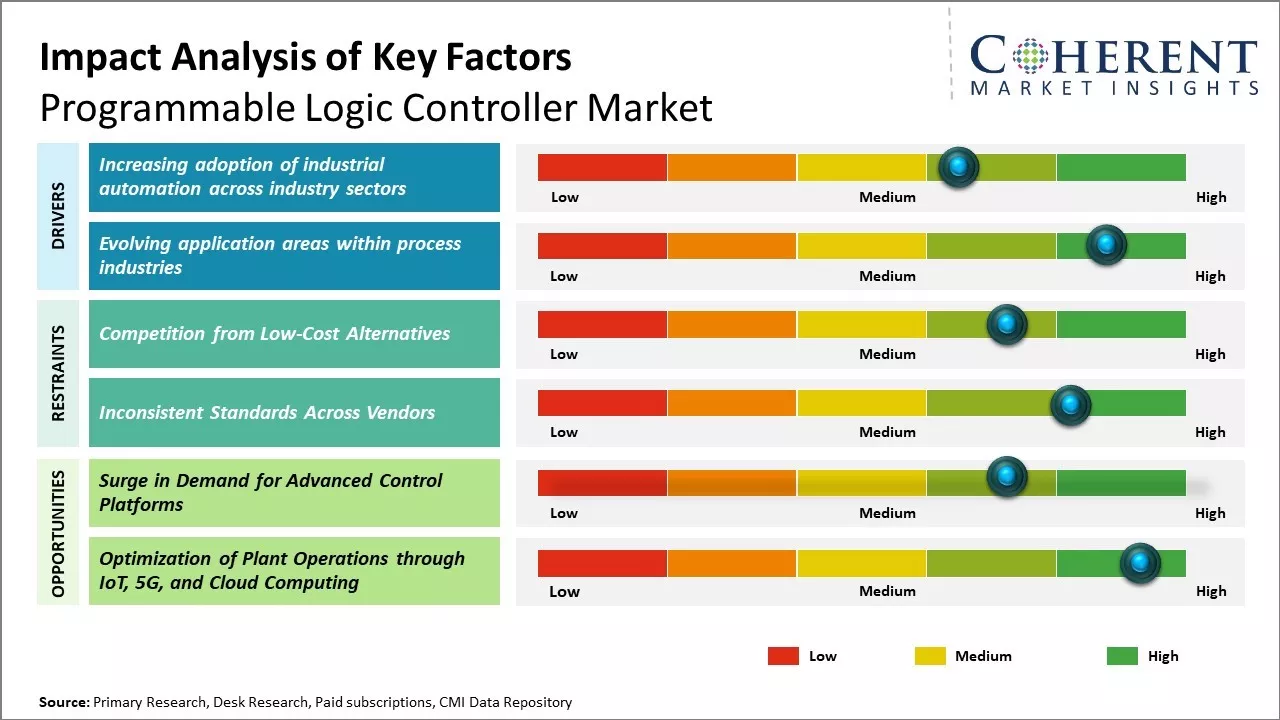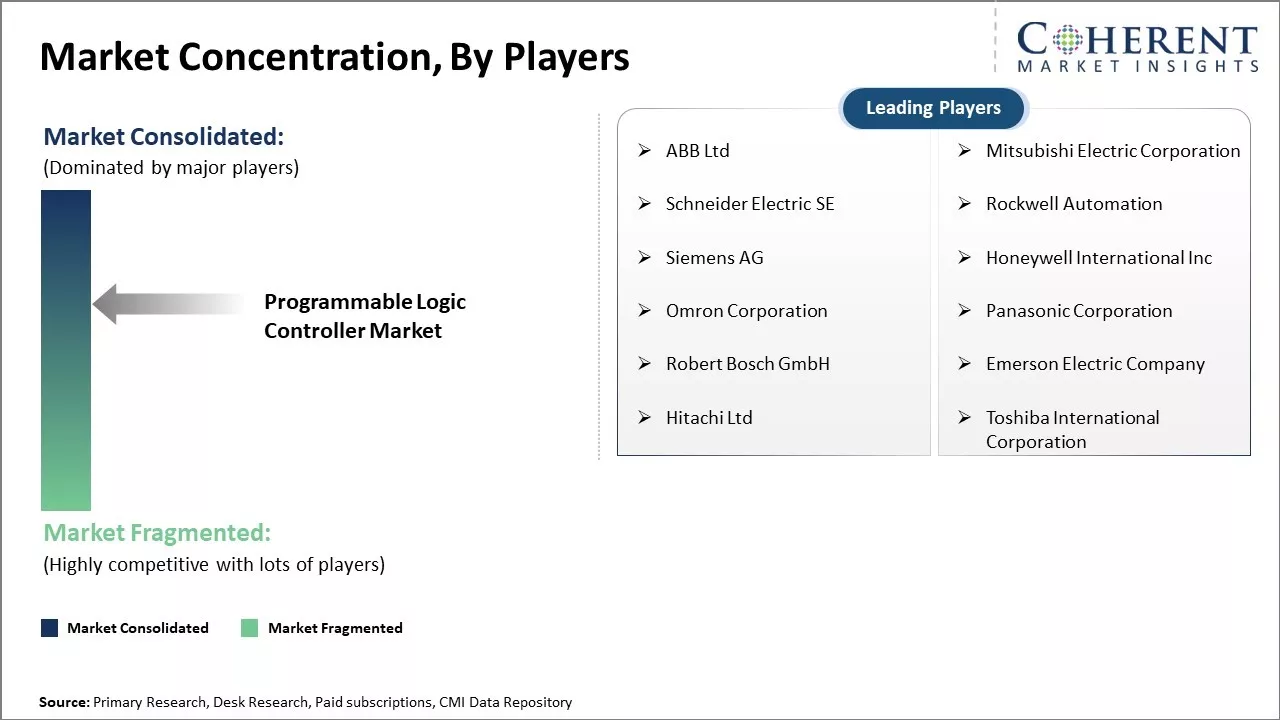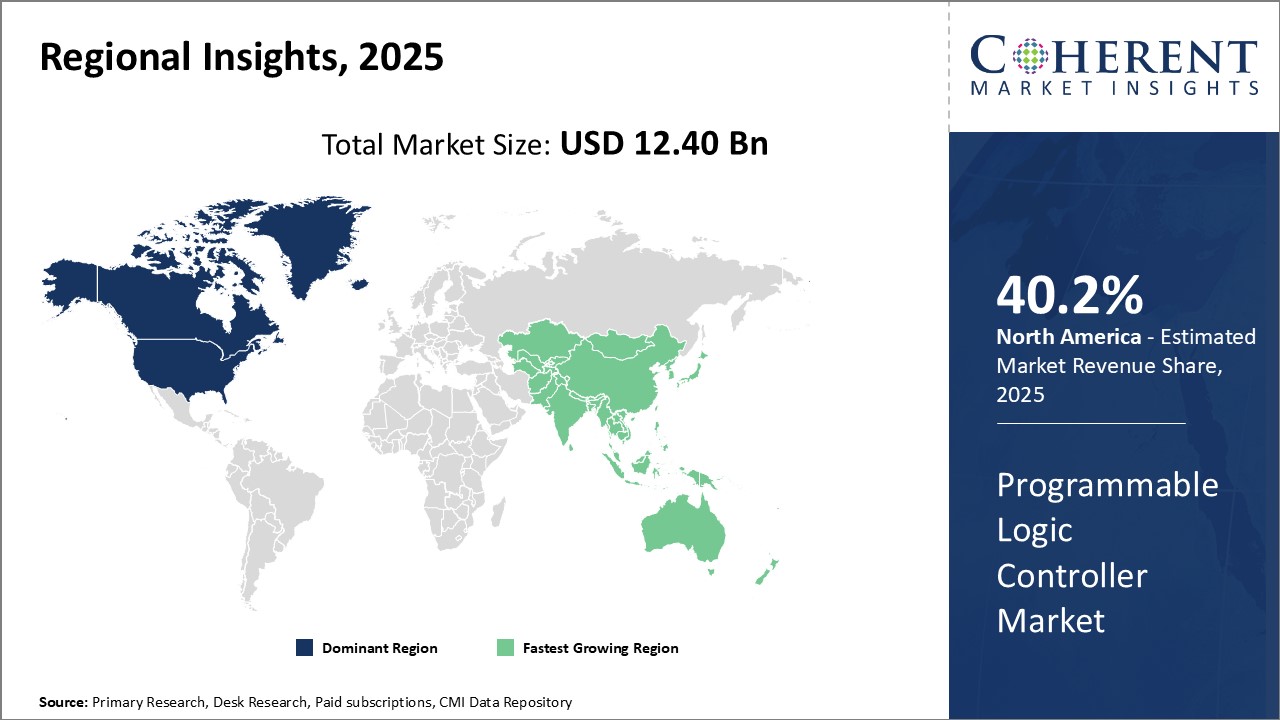The Programmable Logic Controller Market size is estimated to be valued at USD 12.40 Bn in 2025 and is expected to reach USD 16.66 Bn by 2032, exhibiting a compound annual growth rate (CAGR) of 4.3% from 2025 to 2032.

To learn more about this report, Download Free Sample
The programmable logic controllers (PLCs) market demand is anticipated to grow significantly in the coming years. This is mainly due to rising industrial automation along with the adoption of digital technologies across various industries which is likely to increase the use of PLC systems. Moreover, the need to improve operational efficiency and lower production costs is fueling the increase in the use of automation tools. The integration of cloud services, IoT, and edge computing into PLCs is further broadening their areas of application.
|
Event |
Description and Impact |
|
Geopolitical Tensions and Trade Policies |
|
|
Advancements in PLC Technology |
|
|
Cybersecurity Concerns in Industrial Control Systems (ICS) |
|
Uncover macros and micros vetted on 75+ parameters: Get instant access to report
The embrace of Artificial Intelligence (AI) is revolutionizing the market of Programmable Logic Controllers (PLC) as it augments performance, efficiency and dependability in automation systems. Creating business value is of top priority for many corporations, and as such, there is a growing focus on integrating AI technologies into manufacturing operations to further improve productivity.
Integrating AI into PLC systems is transforming industrial automation towards intelligence, proactive management, and higher operational efficiency. With the continued advancement of AI technologies, the PLC market will offer solutions that augment productivity, minimize nonproductive time, and aid the transition to smart, networked factories.
For instance, in September 2024, Schneider Electric launched generative AI into its programming suite. Programmers interact with the AI chatbot in the right rail; code snippets are suggested in the center screen, and can be added to the code tree in the left rail.
The global manufacturing sector has been adopting industrial automation technologies at a rapid pace over the past decade. This is mainly driven by the need to enhance productivity and operational efficiency of production processes across industries. Programmable logic controllers (PLCs) form an integral part of industrial automation systems as they provide the processing and control capabilities needed to automate industrial processes and machinery.
The growing complexity of manufacturing operations is propelling the demand for PLCs that can handle more advanced control functions with ease. More factories are leveraging PLCs to achieve enhanced flexibility in production with capabilities like feedback control, motion control, and communication with other hardware. Industries that involve repetitive and mechanized processes like food and beverage, automotive, semiconductors and electronics have significantly increased their adoption of PLC controlled machines and equipment over the past few years.
This trend is anticipated to continue as more machinery across industries integrates latest digital technologies. The rising need for mass customization is also driving manufacturers to install PLC controlled flexible manufacturing systems. The stringent quality and reliability standards across industries further strengthen the case for automation with advanced PLC systems.
For instance, in January 2020, Hitachi Ltd. a Japanese multinational conglomerate, acquired a robotic system integration provider, JR Automation, to enhance its automation solutions for the manufacturing industry, aiming to offer seamless integration processes to customers.

To learn more about this report, Download Free Sample
Another key factor driving the programmable logic controller market growth is the increasing applications of programmable automation within various process industries. Process control has traditionally relied more on dedicated controllers and networked control systems. However, PLCs are now often preferred over alternative control system choices in many processes automation uses due to their rugged nature and capacity to handle a diverse range of control requirements with ease.
PLCs are playing a greater role in optimizing complex processes within industries like chemicals, mining, oil and gas, pharmaceuticals, pulp and paper, and food and beverage. For example, in oil refineries, PLCs are used for controlling a wide array of critical unit operations and machinery. Their open architecture enables the easy integration of advanced process control and safety instrumentation functions.
PLCs also offer advantages in the maintenance and diagnostics of process control systems. The rising demand for mass customization even within batch process manufacturing is driving more plants to deploy PLC controlled flexible processing systems. Mining operations also depend greatly on PLC automated heavy machinery for various on-site activities.
For instance, in July 2022, Omron Corporation an electronics company, developed CP2E Micro PLC designed for small devices, supporting data collection and machine-to-machine communication. CP2E is a highly effective solution for standalone machines where cost performance is crucial. This series of controllers offers an excellent option for flexible production environments that require machine monitoring and traceability.
The growing demand for automated processes across various industries drives the need for more advanced control platforms. Emerging technologies such as IoT, 5G, and cloud computing open up possibilities to optimize plant operations from remote locations. The adoption of new communication protocols allows for integrating PLCs into more complex and interconnected systems, enhancing overall efficiency, scalability, and real-time data analysis capabilities. This integration facilitates improved decision-making, predictive maintenance, and seamless coordination across different industrial processes.
In terms programming language, ladder logic is expected to contribute the highest Programmable Logic Controller Market Share of 46.8% in 2025, owing to its simplicity and resemblance to traditional relay-based logic systems. Ladder Logic programming replicates the logic of relay-based circuits using vertical and horizontal lines to represent the circuits and connecting links. This makes it intuitive for engineers and technicians familiar with relay circuits to program PLCs using Ladder Logic. It allows application of control specifications with minimum retraining.
In terms of size of the programmable logic controller market analysis, modular PLCs is expected to contribute the highest share of 35.32% in 2025, owing to economical scalability and modular design. Modular PLC systems provide flexibility to start small and scale up hardware and functionality by adding individual modules without replacing the main CPU. This allows optimized initial investment and pay-as-you-grow model according to evolving automation needs.
In terms of industry vertical, the automotive segment is expected to contribute the highest share of 29.98% in 2025. This is attributed to increasing PLC adoption driven by rapid automation and customization needs of the automotive industry. Growing requirements of quality, productivity, and variant manufacturing are compelling automakers to deploy more automated assembly lines, machine tools, and robots.

To learn more about this report, Download Free Sample
North America is anticipated to hold the largest share of 40.2% in the global Programmable Logic Controller Market value in 2025. This dominance stems from the region’s well-established end-use industries such as automotive, oil & gas, food & beverage, and manufacturing, which extensively deploy PLC technologies to optimize operations. The presence of leading PLC vendors with major headquarters and R&D centers in North America enables tailored solutions for a diverse customer base.
Asia Pacific is emerging as the fastest-growing region in the Programmable Logic Controller Market, with a CAGR of 5.41% projected for 2025. Rapid industrialization across developing economies such as China, India, and Southeast Asian countries is the primary growth driver. These nations are witnessing significant investments in new Greenfield industrial parks as well as modernization of existing manufacturing facilities, leading to widespread installation of PLC-based automation systems to boost productivity and quality.
The United States leads the North American PLC market due to its vast industrial base encompassing automotive, oil & gas, food & beverage, and manufacturing sectors that heavily utilize automation technologies. The country benefits from advanced industrial infrastructure, a skilled workforce, and significant investments in R&D by top PLC vendors headquartered there.
Japan holds a leading position in the Asia Pacific robot manufacturing and industrial robotics sector, which directly impacts PLC demand. According to the Japan Statistics Bureau, revenue from robots in Japan is forecasted to reach approximately USD 16.35 billion by 2024. This strong robotics market underpins significant adoption of PLC technologies for automation and process control across Japanese industries.
| Report Coverage | Details | ||
|---|---|---|---|
| Base Year: | 2024 | Market Size in 2025: | USD 12.40 Bn |
| Historical Data for: | 2020 To 2024 | Forecast Period: | 2025 To 2032 |
| Forecast Period 2025 to 2032 CAGR: | 4.3% | 2032 Value Projection: | USD 16.66 Bn |
| Geographies covered: |
|
||
| Segments covered: |
|
||
| Companies covered: |
ABB Ltd, Mitsubishi Electric Corporation, Schneider Electric SE, Rockwell Automation, Siemens AG, Honeywell International Inc, Omron Corporation, Panasonic Corporation, Robert Bosch GmbH, Emerson Electric Company, Hitachi Ltd, and Toshiba International Corporation |
||
| Growth Drivers: |
|
||
| Restraints & Challenges: |
|
||
Uncover macros and micros vetted on 75+ parameters: Get instant access to report
*Definition: The Programmable Logic Controller (PLC) market encompasses companies that manufacture and sell PLCs and related hardware and software. PLCs are digital computers used for the automation of industrial processes like manufacturing, processes, and building automation. PLCs monitor inputs and make decisions based on a custom program to control outputs and machines. They are often used in industries like oil and gas, chemical, automotive, food and beverage processing, pulp and paper processing, electricity generation and distribution and others.
Share
Share
About Author
Monica Shevgan has 9+ years of experience in market research and business consulting driving client-centric product delivery of the Information and Communication Technology (ICT) team, enhancing client experiences, and shaping business strategy for optimal outcomes. Passionate about client success.
Missing comfort of reading report in your local language? Find your preferred language :
Transform your Strategy with Exclusive Trending Reports :
Frequently Asked Questions
Joining thousands of companies around the world committed to making the Excellent Business Solutions.
View All Our Clients